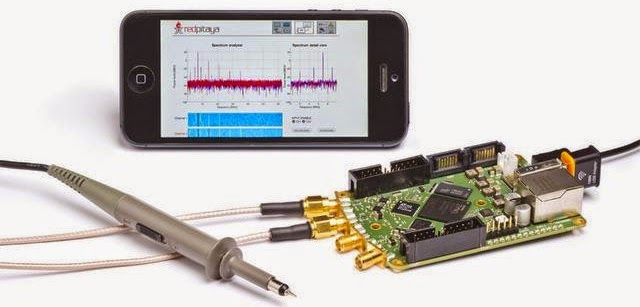RED PITAYA – An All-in-One Oscilloscope, Function Generator, Spectrum & Frequency Analyser
A low cost, portable Control & Instruments device that claims to replace expensive lab and field instruments.We are in the era of mobiles, gadgets and instruments that are portable, packed with lot of features, have web connectivity and available at a very economical price point. Pick up any electronic gadget or instrument and it will fit in this definition, so why should test and measurement instruments take a back seat!
Introducing RED PITAYA - an innovative single board, low cost, high spec, multifunctional and portable PCB based electronic Test & Measurement Device that aims to replace expensive lab and field instruments.
RED PITAYA – Open Source T&M Device
FeaturesRED PITAYA is a programmable device powered by Xilinx Zynq7000 SoC that combines dual core ARM & FPGA and runs on Linux. It uses open source ecosystem approach which let users to download standard applications from 'Bazaar' and customize these applications at various programming levels and also develop new applications using source code and documentation available from 'Backyard'.
It is an ideal platform for electronic enthusiasts, students and universities, HAM Radio operators and research institutes.
Red Pitaya In Action
Hardware Specifications of Red PitayaInputs:-1. The main inputs are two independent channels that run at 125MS/s with 14-bit resolution
2. Four low speed inputs, each at 100kS/s and 12-bit resolution.
Outputs:-1. Two main analogue outputs at 125MS/s and 14-bit.
2. Four low speed outputs, each at 100kS/s and 12-bit resolution.
Expansion is possible via USB (to add a flash drive, WLAN adapter or camera for instance), and also via a connector that provides 16x FPGA pins for GPIO (e.g. for a custom add-on module). The instrument is typically accessed over Ethernet via a web interface and can be easily connected to local networks. Users can connect to it by simply writing its IP in the address bar for their browsers.
It is also possible to log in, execute remote commands and transfer data via SSH. A handy USB UART interface provides access to the SoC serial console for configuration and debugging.
Hardware Specifications of RED Pitaya
Standard Applications/Functionalities
Oscilloscope - 2 channels @ 125 MS/s 14 bit digital with external or signal based triggering capability
Spectrum Analyser - 2 channels with 50 MHz bandwidth signal with waterfall diagram capability
Arbitrary Waveform Generator - 2 channels @ 125 MHz 14 bit arbitrary waveform generation with external triggering capability
Frequency Response Analyser - 2 channels with 60 MHz bandwidth
The web interface enables access to Red Pitaya’s functionality from the majority of browsers. Applications are available on iPhone, iPad, other smartphones, tablets and PCs.
Software Functionalities, Programming
Red Pitaya can be customised for specific applications above its standard specification. It is based on GNU/Linux operating system and can be customised at different programming levels. Available software interfaces include:
- HDL
- C/C++
- Scripting languages
- Matlab
- HTML based web interfaces
Red Pitaya Target Audience
ELECTRONICS ENTHUSIASTS. Red Pitaya is a great springboard for electronics enthusiasts, because it offers great user interface and can be easily reconfigured for any kind of interaction with outside world by simply modifying the available applications. Out-of-the-box applications, such as oscilloscope or spectrum analyzer, enable fast debugging of electronic projects
STUDENTS. The learning process is simplified by Red Pitaya Backyard containing all the application's source code. Students can start programming by applying incremental changes to the code and publish their work in Bazaar and easily get in touch with a wide range of technologies and knowledge. It is also very appropriate for PhD or other research projects
TEACHERS & PROFESSORS. Red Pitaya is a compact replacement for several expensive instruments and also a universal teaching tool. It enables learning of WEB and embedded application programming, FPGA, signal processing, machine vision applications and it can be controlled by Matlab as well.
HAM RADIO OPERATORS. Amateur radio community uses a wide set of instruments such as SWR meter, network analyzer etc. Red Pitaya has a potential to replace them all. Besides that it can also be used as a radio station or software defined radio (SDR)
RESEARCH INSTITUTIONS. Red Pitaya is very suitable solution for detecting and analyzing fast phenomena, as well as generating or simulating complex signals.
To Conclude
RED Pitaya with its out-of-the-box features, applications & high spec caters to the requirements of all electronics professional working in different areas & on different applications that too at a very affordable price. It is not hard to believe that in coming days RED PITAYA with so much of distinguished features can become inseparable/invaluable device for any electronics lab, design house, R&D center, and university.
Sourced By: EFY:













